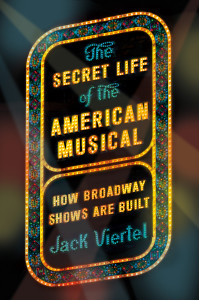Revealing the concealed underpinnings and durable structures of American musicals is no easy undertaking. Let alone covering and analyzing the past seven decades of musical theater history. But, Broadway veteran Jack Viertel provides an invaluable, breezy, quite personal accounting of Broadway’s Golden Age up to the current mega-hit Hamilton. It all appears in his new book, The Secret Life of the American Musical: How Broadway Shows Are Built.

The Secret Life of the American Musical is an ideal source book for those enthralled with American Musical Theatre, if they know each and every show mentioned by Viertel, or can sing the lyrics and hum the tunes. For other readers, let’s say Millennials for whom the “Golden Age” may seem like something to roll their eyes thinking of their grandparents and nostalgia, The Secret Life of the American Musical will be invaluable addition to their musical theater bookshelf for its cogent analysis and personal perspectives from a Broadway veteran who now also teaches about theater at the Tisch School of the Arts, at New York University.
Since the name Jack Viertel may not be immediately familiar, he is the Senior Vice President of Jujamcyn Theaters the company that owns and operates five different Broadway venues. Currently, the Jujamcyn theaters are running musicals such as The Book of Mormon, Kinky Boots, Something Rotten, and Jersey Boys.
Over the past decades, Viertel has been involved in dozens of productions including Pulitzer Prize and Tony Award winners. He is also the Artistic Director of New York City Center’s famed Encores! series. This season’s Encores! productions include Cabin in the Sky, 1776, and Do I Hear a Waltz? To add to his bona fides, as if it was needed, Viertel teaches musical theater at the Tisch School of the Arts at New York University.
Viertel is clear about his definition of Broadway’s Golden Age. It is the time from the opening night of Oklahoma! on March 31, 1943 to the opening night of A Chorus Line on July 25, 1975. In the course of reading The Secret Life of the American Musical, readers will run into names and titles that will bring bright smiles and audible sighs to Baby Boomers. Many will recall the shows, performers, songs mentioned as providing politically progressive guide stars for their lives while rock and roll provided a bedrock sound track to their a times of perhaps rebellion to annoy the most left-leaning parent.
For Broadway mavens, Viertel has gathered up the usual suspects of show titles to delve, in no particular order shows with these tiles: Oklahoma!, My Fair Lady, West Side Story, The Music Man, Guys and Dolls, South Pacific, A Funny Thing Happened on the Way to the Forum, Company, A Chorus Line, Gypsy, Sweeny Todd, Cabaret, Fiddler on the Roof, Mame, Hair, Hello Dolly, and Follies to provide a small list. And of course, those that built these hits including the likes of Rodgers and Hammerstein, Hal Prince and Stephen Sondheim, Frank Loesser, Jerry Herman, and Kander and Ebb. The list of performers and song titles in the index is huge.
Then, in a nod to his NYU students as a starting point, he also fully writes about shows like Rent, Wicked, The Book of Mormon, Spring Awakening, Next to Normal (tinkered with and improved at Arena Stage before a successful run in New York City) , Dear Evan Hansen (produced at Arena Stage in 2015) and the current mega-hit Hamilton. With these newer shows he provides excellent analysis to clearly illuminate how they each of these newer shows share the structures of Golden Age Broadway musicals. The music and story lines and characters may differ considerably from older American musicals, but the differences are only skin deep. Older or new, the shows that Viertel showcases, does what a successful musical must do: the music seduces, the lyrics reveal.

Through nineteen easily digested, Viertel coalesces around these points. Successful musicals have similar structures. They include an opening number with its what kind of show Is this going to be, an “I want” song to hook the audience, a conditional love song that provides some wobbles for the audience to not become too comfortable, with a musical number full of pop, energy, and noise to make sure patrons are awake in their seats. Then add in a second couple who add some more interest along with a villain to make the evening’s journey not so quick and easy to figure out.
The second act needs some complications that keep the audience enthralled, an obligatory star-turn and of course, those delightful Broadway musical terms, tent poles and 11 o’clock numbers, leading up to the curtain and hopefully, long sustained applause.
Ok, now, that is Viertel’s book. For this reviewer, what The Secret Life of the American Musical: How Broadway Shows Are Built did was leave me thinking of what next for the American musical. All things do have a life, right? Things don’t stay the same, going on forever do they? A life of 75 years is a pretty decent time for the current way musicals are structured.
The book left me wondering about the future. What will be the impact of the digital age and the current generation known for being disrupters? Millennials have been successful at disrupting and replacing much of what Baby Boomers built in the real word of commerce, communication, and living. Why should the American musical be left untouched? Who knows what technologists will come up with that will affect the American musical.
There is also the ever increasing changes in American demographics that by 2050 or so will leave American a majority-minority population. How will musical stories be told of the people from say Vietnam, Syria, Central America, and India? Will they not want to use their own cultural references and structures rather than current the Western cannon of Broadway and American musicals?
Will the seemingly progressive values of American musicals continue as one awaits the outcomes of current cultural, social and political debates? With a mainstream, will musicals no longer be “ties that bind” as audiences fall into niches like on cable news?
Viertel leaves much to chew about the future. The Secret Life of the American Musical is a book of riches and gems from Broadway’s Golden Days through today. As for tomorrow, well I guess Annie was right: we will always have tomorrow to imagine.
Note: The Secret Life of the American Musical: How Broadway Shows are Built by Jack Viertel. Sarah Crichton Books: Farrar, Straus and Giroux, New York. 313 pages, includes index and discography. ISBN 978-0-374-25692-0. Purchase the book here.




